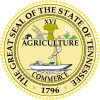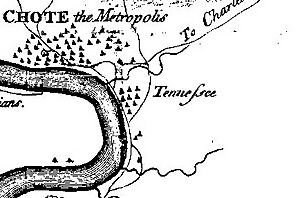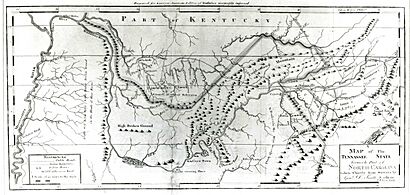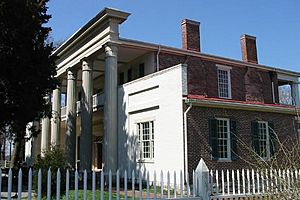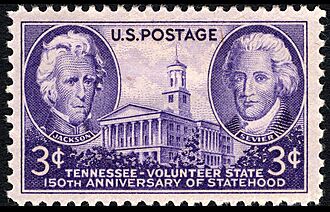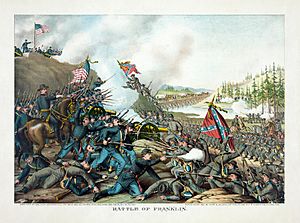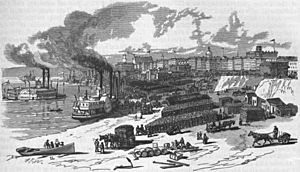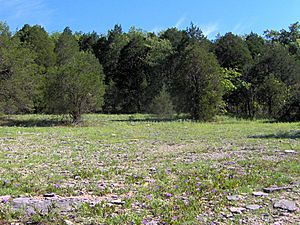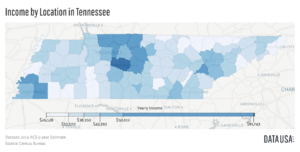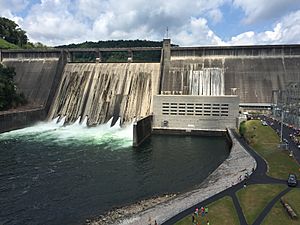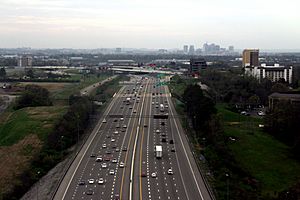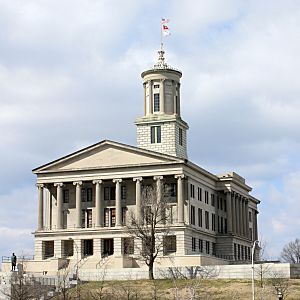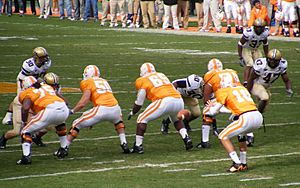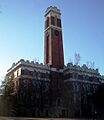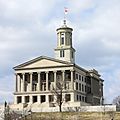Tennessee facts for kids
Quick facts for kids
Tennessee
|
|||
|---|---|---|---|
|
|||
| Nickname(s):
The Volunteer State
|
|||
| Motto(s):
Agriculture and Commerce
|
|||
| Anthem: Eleven songs | |||
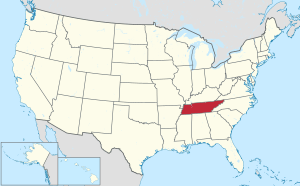
Location of Tennessee within the United States
|
|||
| Country | United States | ||
| Before statehood | Southwest Territory | ||
| Admitted to the Union | June 1, 1796 (16th) | ||
| Capital (and largest city) |
Nashville | ||
| Largest county or equivalent | Shelby | ||
| Largest metro and urban areas | Nashville | ||
| Legislature | General Assembly | ||
| • Upper house | Senate | ||
| • Lower house | House of Representatives | ||
| Judiciary | Tennessee Supreme Court | ||
| U.S. senators | Marsha Blackburn (R) Bill Hagerty (R) |
||
| U.S. House delegation | 8 Republicans 1 Democrat (list) |
||
| Area | |||
| • Total | 42,181 sq mi (109,247 km2) | ||
| • Land | 41,235 sq mi (106,898 km2) | ||
| • Water | 909 sq mi (2,355 km2) 2.2% | ||
| Area rank | 36th | ||
| Dimensions | |||
| • Length | 440 mi (710 km) | ||
| • Width | 120 mi (195 km) | ||
| Elevation | 900 ft (270 m) | ||
| Highest elevation
(Kuwohi, formerly Clingmans Dome)
|
6,643 ft (2,025 m) | ||
| Lowest elevation
(Mississippi River at Mississippi border)
|
178 ft (54 m) | ||
| Population
(2024)
|
|||
| • Total | |||
| • Rank | 15th | ||
| • Density | 171.0/sq mi (65.9/km2) | ||
| • Density rank | 20th | ||
| • Median household income | $67,600 (2023) | ||
| • Income rank | 42nd | ||
| Demonym(s) | Tennessean Big Bender (archaic) Volunteer (historical significance) |
||
| Language | |||
| • Official language | English | ||
| • Spoken language | Language spoken at home | ||
| Time zones | |||
| East Tennessee except for Bledsoe, Cumberland, and Marion counties | UTC−05:00 (Eastern) | ||
| • Summer (DST) | UTC−04:00 (EDT) | ||
| Middle and West Tennessee, and Bledsoe, Cumberland, and Marion counties | UTC−06:00 (Central) | ||
| • Summer (DST) | UTC−05:00 (CDT) | ||
| USPS abbreviation |
TN
|
||
| ISO 3166 code | US-TN | ||
| Traditional abbreviation | Tenn. | ||
| Latitude | 34°59′ N to 36°41′ N | ||
| Longitude | 81°39′ W to 90°19′ W | ||
| Dance | Square dance |
|---|---|
| Bird | Northern mockingbird Bobwhite quail |
| Fish | Channel catfish Smallmouth bass |
| Flower | Iris Passion flower Tennessee echinacea |
| Tree | Tulip poplar Eastern red cedar |
| Insect | Firefly Lady beetle Honey bee |
Tennessee is a state in the Southeastern United States. It is surrounded by land, meaning it has no coastlines. Tennessee shares borders with eight other states, including Kentucky and Virginia to the north, and North Carolina to the east. To the south, it borders Georgia, Alabama, and Mississippi. To the west, it borders Arkansas and Missouri.
Tennessee is the 36th largest state by land area and the 15th most populated. As of 2024, about 7.22 million people live there. The state is split into three main parts: East, Middle, and West Tennessee. Nashville is the capital and largest city. It is also the center of the state's biggest metropolitan area.
Tennessee has many different types of land, from mountains to flat plains. The Blue Ridge Mountains in the east have some of the highest points in eastern North America. The Cumberland Plateau features beautiful valleys and waterfalls. The middle of the state has rolling hills and caves. West Tennessee is known for its flat, fertile plains. The Tennessee River flows through the state twice, and the Mississippi River forms its western border. The Great Smoky Mountains National Park, a very popular national park, is located in eastern Tennessee.
Tennessee's history began with the Watauga Association in 1772. This was one of the first governments west of the Appalachian Mountains. The state's name comes from "Tanasi," a Cherokee town. Tennessee was first part of North Carolina, then the Southwest Territory. It became the 16th U.S. state on June 1, 1796. It earned the nickname "The Volunteer State" because many of its citizens have served in the military.
During the American Civil War, Tennessee was divided. Most of its western and middle parts supported the Confederacy. However, many people in the eastern part supported the Union. Tennessee was the last state to leave the Union and the first to rejoin it after the war.
In the 1900s, Tennessee changed from a farming state to one with many different industries. This was helped by projects like the Tennessee Valley Authority (TVA). During World War II, Oak Ridge was built for the Manhattan Project, which created the first atomic bombs. Today, Tennessee's economy relies on health care, music, finance, and tourism. It also produces cattle, soybeans, and cotton. Tennessee has also been very important in developing many types of popular music, like country, blues, and rock and roll.
Contents
- Etymology: How Tennessee Got Its Name
- History: A Look Back at Tennessee
- Geography: The Lay of the Land
- Cities and Counties: Where People Live
- Demographics: Who Lives in Tennessee?
- Economy: How Tennessee Makes Money
- Culture: Music, Food, and More
- Education: Learning in Tennessee
- Media: News and Entertainment
- Transportation: Getting Around Tennessee
- Law and Government: How Tennessee is Run
- Politics: How Tennessee Votes
- Sports: Teams and Events
- Images for kids
- See also
Etymology: How Tennessee Got Its Name
The name Tennessee comes from the Cherokee town of Tanasi. This town was located in what is now Monroe County, Tennessee, on the Tanasi River (now called the Little Tennessee River).
In 1567, a Spanish explorer named Captain Juan Pardo found a Native American village called "Tanasqui" in the area. It is not known if this was the same town as Tanasi. The town appeared on British maps as early as 1725. Some research suggests the Cherokees got the name from the Yuchi word Tana-tsee-dgee. This means "brother-waters-place" or "where-the-waters-meet."
The modern spelling, Tennessee, was first used by Governor James Glen of South Carolina in the 1750s. In 1788, North Carolina created "Tennessee County." Then, in 1796, a meeting to organize the new state chose "Tennessee" as its name.
History: A Look Back at Tennessee
Early People and European Arrival
The first people in Tennessee were Paleo-Indians who arrived about 12,000 years ago. They were hunter-gatherers. Later groups, like the Archaic, Woodland, and Mississippian cultures, lived here. The Mississippian people built large ceremonial mounds.
Spanish explorers like Hernando de Soto visited the area in the 1500s. By the early 1700s, many Native Americans had disappeared, likely due to diseases brought by Europeans. The Cherokee began moving into eastern Tennessee in the late 1600s. They pushed out other tribes like the Creek, Yuchi, and Shawnee. The Chickasaw stayed in West Tennessee.
Exploration and Early Settlements
In 1673, English fur traders explored northeastern Tennessee. French explorers also mapped the Mississippi River and built Fort Prudhomme in West Tennessee in 1682. In 1714, the French set up a fur trading post called French Lick, where Nashville is today.
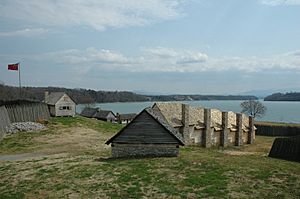
British settlers built Fort Loudoun in 1756. This was the first British settlement in Tennessee. However, fighting broke out with the Cherokees, and the fort was surrendered in 1760. After the French and Indian War, Britain tried to stop settlements west of the Appalachian Mountains. But people kept moving there.
The first permanent European settlers arrived in northeastern Tennessee in the late 1760s. They formed the Watauga Association in 1772. This was a self-governing group. During the American Revolutionary War, they supported the American cause.
In 1775, Richard Henderson made agreements with the Cherokee to sell land. Daniel Boone then blazed a trail called the Wilderness Road. This path helped many settlers move into Tennessee. In 1779, James Robertson and John Donelson led settlers to French Lick, where they built Fort Nashborough. This settlement later became Nashville.
In 1784, three counties broke away from North Carolina to form the State of Franklin. This state tried to join the U.S. but failed. By 1788, these counties rejoined North Carolina. In 1790, North Carolina gave the land to the federal government. It became the Southwest Territory. The territory could become a state once its population reached 60,000.
Becoming a State and Early Years
As more people wanted statehood, a census was taken in 1795. It showed 77,263 people lived in the territory. In January 1796, a meeting was held to write a state constitution. The name Tennessee was chosen for the new state. On June 1, 1796, Tennessee became the 16th state.
Tennessee got its nickname "The Volunteer State" during the War of 1812. About 3,500 Tennesseans joined the war effort. These soldiers, led by Andrew Jackson, helped win the Battle of New Orleans in 1815. Many Tennesseans also fought in the Texas Revolution in 1835–36.
Between the 1790s and 1820s, more land was acquired from the Cherokee. In 1818, the "Jackson Purchase" added all of West Tennessee. This land was bought from the Chickasaw. In 1838 and 1839, thousands of Cherokees were forced to leave their homes in southeastern Tennessee. They were made to march to Indian Territory (now Oklahoma). This sad event is known as the Trail of Tears.
The Civil War and Its Aftermath
When the American Civil War began, many people in Middle and West Tennessee wanted to protect their way of life. However, most people in East Tennessee wanted to stay in the Union. Tennessee was a very important state during the war. It saw more battles than any state except Virginia.
In February 1861, voters rejected leaving the United States. But after the attack on Fort Sumter, Tennessee joined the Confederacy on May 7, 1861. On June 8, voters approved leaving the Union, making Tennessee the last state to secede.
Union forces captured the Tennessee and Cumberland rivers in February 1862. They won battles at Fort Henry and Fort Donelson. The Battle of Shiloh in April was one of the bloodiest battles of the war. Memphis fell to the Union in June. Union forces also won key battles at Stones River and during the Chattanooga campaign.
The last major battles in Tennessee happened in late 1864. Confederate forces invaded Middle Tennessee but were defeated at Franklin and Nashville. On April 27, 1865, the Sultana steamboat exploded on the Mississippi River. This killed 1,168 people, mostly freed Union prisoners.
On October 24, 1864, all enslaved people in Tennessee were declared free. On February 22, 1865, the state approved an amendment to its constitution to ban slavery. This made Tennessee the only Southern state to do so at that time. Tennessee was the first Confederate state to have its elected members allowed back into Congress on July 24, 1866.
Late 1800s and Early 1900s
After the Civil War, there was tension between Black people and former Confederates. The Ku Klux Klan was formed in Pulaski in December 1865. In 1870, Southern Democrats took control of the state government. They passed laws that enforced segregation.
Memphis became known as the "Cotton Capital of the World" in the late 1800s. Chattanooga became one of the first industrial cities in the South. In 1891 and 1892, miners protested a system where prisoners were forced to work. This led to the state ending this practice.
In 1897, Tennessee celebrated its 100th birthday with an event in Nashville. A full-size replica of the Parthenon from Athens, Greece, was built for the celebration.
The 20th Century and Beyond
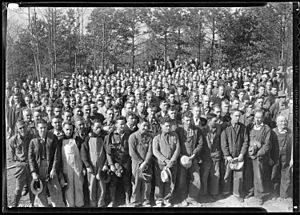
Many Black Tennesseans moved to northern cities between 1915 and 1930. This was part of the Great Migration. In 1920, Tennessee became the 36th state to approve the Nineteenth Amendment to the United States Constitution. This gave women the right to vote.
In 1925, a teacher named John T. Scopes was tried for teaching evolution in Dayton. This case, known as the Scopes Trial, drew national attention. In 1926, the Great Smoky Mountains National Park was created.
When the Great Depression hit in 1929, Tennessee was very poor. The Tennessee Valley Authority (TVA) was created in 1933. The TVA built dams to provide electricity, jobs, and flood control. This helped the state's economy grow.
During World War II, East Tennessee was chosen for the Manhattan Project. This project developed the first atomic bombs. The city of Oak Ridge was built for the workers. After the war, the Oak Ridge National Laboratory became a key science research center.
In 1955, Oak Ridge High School was the first school in Tennessee to allow students of all races. In 1960, sit-ins in Nashville led to the end of segregation at lunch counters. On April 4, 1968, civil rights leader Martin Luther King Jr. was assassinated in Memphis.

The 1982 World's Fair was held in Knoxville. Its theme was "Energy Turns the World." In 1996, Tennessee celebrated its 200th birthday. A new state park, Bicentennial Mall, opened in Nashville. The 1996 Summer Olympics whitewater events were held on the Ocoee River in Polk County.
In 2008, a large industrial waste spill happened at TVA's Kingston Fossil Plant. More than 1.1 billion gallons of coal ash spilled into rivers. The cleanup cost over $1 billion.
Geography: The Lay of the Land
Tennessee is in the Southeastern United States. It covers about 42,143 square miles (109,247 km2). About 2.2% of this area is water. It is the 16th smallest state in land area. The state is about 440 miles (710 km) long from east to west and 112 miles (195 km) wide from north to south.
Tennessee is divided into three main parts: East Tennessee, Middle Tennessee, and West Tennessee. It borders eight other states. This ties it with Missouri for bordering the most states. The Tennessee River divides the state, and its center is in Murfreesboro. Most of the state is in the Central Time Zone.
Tennessee's eastern border follows the highest points of the Blue Ridge Mountains. The Mississippi River forms its western border. The state's highest point is Kuwohi (formerly Clingmans Dome), at 6,643 feet (2,025 m) above sea level. Its lowest point is 178 feet (54 m) on the Mississippi River. Tennessee has over 10,000 caves, the most in the United States.
Tennessee has six main land regions. These include the Blue Ridge Mountains, Ridge-and-Valley Appalachians, and Cumberland Plateau. Other regions are the Highland Rim, Nashville Basin, and East Gulf Coastal Plain. The state is also seismically active, meaning it has earthquakes. The New Madrid seismic zone in the northwest caused major earthquakes in 1811–1812. These earthquakes formed Reelfoot Lake.
Land Features of Tennessee
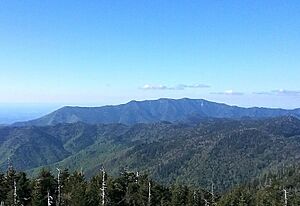
The Blue Ridge Mountains are in eastern Tennessee. They include the Great Smoky Mountains and other ranges. These mountains are very high, averaging 5,000 feet (1,500 m) above sea level. Much of this area is protected by national forests and parks. The Appalachian Trail also runs through this region.
West of the Blue Ridge Mountains are the Ridge-and-Valley Appalachians. This area has long, parallel ridges and valleys. Many rivers in this region join to form the Tennessee River.
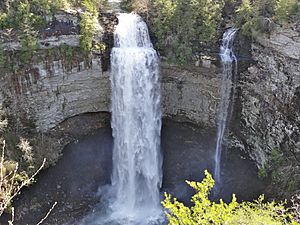
The Cumberland Plateau is west of the Tennessee Valley. It averages 2,000 feet (600 m) high and has flat-topped areas. Its edges have rocky cliffs and many waterfalls, like Fall Creek Falls.
West of the Cumberland Plateau is the Highland Rim. This is a raised plain that surrounds the Nashville Basin. The Nashville Basin has rich, fertile farmland. Both areas have limestone bedrock close to the surface, which creates many caves and sinkholes.
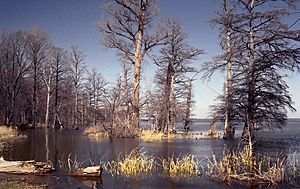
The Western Tennessee Valley is a hilly area along the Tennessee River. West of this is the Gulf Coastal Plain. This plain starts with low rolling hills and then becomes flat. It ends at steep bluffs overlooking the Mississippi embayment. This flat strip is known as the Mississippi Bottoms and has lowlands, floodplains, and swamps.
Rivers and Waterways
Tennessee has three major rivers: the Tennessee, Cumberland, and Mississippi. The Tennessee River starts in Knoxville and flows southwest. The Cumberland River flows through north-central Tennessee, passing through Nashville. The Mississippi River drains most of West Tennessee.
Many dams on these rivers create large reservoirs. About half of the state's land is in the Tennessee River's drainage basin. Most of West Tennessee is in the Lower Mississippi River watershed.
Nature and Wildlife
Tennessee is known for its amazing variety of plants and animals. It is the most biodiverse inland state. The Great Smoky Mountains National Park has the most different types of plants and animals of any national park. The Duck River is the most biologically diverse waterway in North America.
Tennessee is home to 340 types of birds, 325 types of freshwater fish, 89 mammals, 77 amphibians, and 61 reptiles. Forests cover about 52% of the state. Common animals include white-tailed deer, raccoons, and squirrels. Black bears live in the Blue Ridge Mountains. Tennessee has the most salamander species in the world.
Middle Tennessee has unique ecosystems called cedar glades. These areas have shallow limestone bedrock and many rare plant species.
Climate and Weather
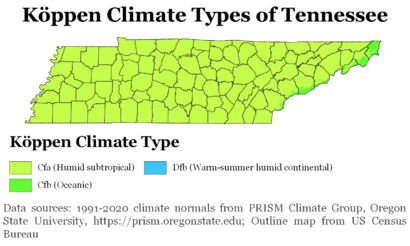
Most of Tennessee has a humid subtropical climate. This means it has hot, humid summers and mild to cool winters. Winds from the Gulf of Mexico bring most of the state's rain. The wettest months are usually December to April. The driest months are August to October.
The state gets about 50 inches (127 cm) of rain each year. Snowfall varies from 5 inches (13 cm) in West Tennessee to over 80 inches (200 cm) in the highest mountains.
Summers are generally hot and humid, with highs around 90°F (32°C). Winters are mild to cool, with average lows near freezing. The highest temperature ever recorded was 113°F (45°C) in Perryville in 1930. The lowest was -32°F (-36°C) in Mountain City in 1917.
Tennessee can experience severe thunderstorms and tornadoes. The state averages 15 tornadoes each year. Winter storms and ice storms also happen sometimes.
| Monthly Normal High and Low Temperatures For Various Tennessee Cities (F) | ||||||||||||
| City | Jan | Feb | Mar | Apr | May | Jun | Jul | Aug | Sep | Oct | Nov | Dec |
|---|---|---|---|---|---|---|---|---|---|---|---|---|
| Bristol | 44/25 | 49/27 | 57/34 | 66/41 | 74/51 | 81/60 | 85/64 | 84/62 | 79/56 | 68/43 | 58/35 | 48/27 |
| Chattanooga | 50/31 | 54/33 | 63/40 | 72/47 | 79/56 | 86/65 | 90/69 | 89/68 | 82/62 | 72/48 | 61/40 | 52/33 |
| Knoxville | 47/30 | 52/33 | 61/40 | 71/48 | 78/57 | 85/65 | 88/69 | 87/68 | 81/62 | 71/50 | 60/41 | 50/34 |
| Memphis | 50/31 | 55/36 | 63/44 | 72/52 | 80/61 | 89/69 | 92/73 | 92/72 | 86/65 | 75/52 | 62/43 | 52/34 |
| Nashville | 47/28 | 52/31 | 61/39 | 70/47 | 78/57 | 85/65 | 89/70 | 89/69 | 82/61 | 71/49 | 59/40 | 49/32 |
Cities and Counties: Where People Live
Tennessee has 95 counties, each with a county seat. There are 340 cities and towns in total. Ten metropolitan areas are in Tennessee, with some extending into nearby states.
Nashville is the capital and largest city, with almost 700,000 people. Its metropolitan area has about 2 million residents and is growing fast. Memphis is the second-largest city, with over 630,000 people. It is in Shelby County, the largest county by population and area.
Knoxville (about 190,000 people) and Chattanooga (about 180,000 people) are the third and fourth largest cities. Clarksville has about 170,000 residents. Murfreesboro is the sixth-largest city and Nashville's biggest suburb. The Tri-Cities (Kingsport, Bristol, and Johnson City) are another major population center.
|
Largest cities or towns in Tennessee
Source: |
||
|---|---|---|
| Rank | Name | Pop. |
| 1 | Nashville | 689,447 |
| 2 | Memphis | 633,104 |
| 3 | Knoxville | 190,740 |
| 4 | Chattanooga | 181,099 |
| 5 | Clarksville | 166,722 |
| 6 | Murfreesboro | 152,769 |
| 7 | Franklin | 83,454 |
| 8 | Johnson City | 71,046 |
| 9 | Jackson | 68,205 |
| 10 | Hendersonville | 61,753 |
Demographics: Who Lives in Tennessee?
| Historical population | |||
|---|---|---|---|
| Census | Pop. | %± | |
| 1790 | 35,691 | — | |
| 1800 | 105,602 | 195.9% | |
| 1810 | 261,727 | 147.8% | |
| 1820 | 422,823 | 61.6% | |
| 1830 | 681,904 | 61.3% | |
| 1840 | 829,210 | 21.6% | |
| 1850 | 1,002,717 | 20.9% | |
| 1860 | 1,109,801 | 10.7% | |
| 1870 | 1,258,520 | 13.4% | |
| 1880 | 1,542,359 | 22.6% | |
| 1890 | 1,767,518 | 14.6% | |
| 1900 | 2,020,616 | 14.3% | |
| 1910 | 2,184,789 | 8.1% | |
| 1920 | 2,337,885 | 7.0% | |
| 1930 | 2,616,556 | 11.9% | |
| 1940 | 2,915,841 | 11.4% | |
| 1950 | 3,291,718 | 12.9% | |
| 1960 | 3,567,089 | 8.4% | |
| 1970 | 3,923,687 | 10.0% | |
| 1980 | 4,591,120 | 17.0% | |
| 1990 | 4,877,185 | 6.2% | |
| 2000 | 5,689,283 | 16.7% | |
| 2010 | 6,346,105 | 11.5% | |
| 2020 | 6,910,840 | 8.9% | |
| 2024 (est.) | 7,227,750 | 13.9% | |
| Source: 1910–2020 | |||
The 2020 census reported Tennessee's population at 6,910,840. This was an increase of 8.90% since the 2010 census. As of 2024, the estimated population is 7.22 million.
Tennessee has seen many people move there from other states. This is because of the lower cost of living and good job opportunities. In 2019, about 5.5% of Tennessee's population was born in other countries.
Ethnic Backgrounds
| Race and Ethnicity | Alone | Total | ||
|---|---|---|---|---|
| White (non-Hispanic) | 70.9% |
|
74.6% |
|
| African American (non-Hispanic) | 15.7% |
|
17.0% |
|
| Hispanic or Latino | — | 6.9% |
|
|
| Asian | 1.9% |
|
2.5% |
|
| Native American | 0.2% |
|
2.0% |
|
| Pacific Islander | 0.1% |
|
0.1% |
|
| Other | 0.1% |
|
0.3% |
|
| Historical racial composition | 1940 | 1970 | 1990 | 2000 | 2010 | 2020 |
|---|---|---|---|---|---|---|
| White | 82.5% | 83.9% | 83.0% | 80.2% | 77.6% | 72.2% |
| Black | 17.4% | 15.8% | 16.0% | 16.4% | 16.7% | 15.8% |
| Asian | - | 0.1% | 0.7% | 1.0% | 1.4% | 2.0% |
| Native | - | 0.1% | 0.2% | 0.3% | 0.3% | 0.4% |
| Native Hawaiian and other Pacific Islander |
- | - | – | – | 0.1% | 0.1% |
| Other race | - | - | 0.2% | 1.0% | 2.2% | 3.6% |
| Two or more races | - | - | – | 1.1% | 1.7% | 6.0% |
In 2020, 6.9% of the population was of Hispanic or Latino origin. This was up from 4.6% in 2010. The Hispanic population in Tennessee grew very quickly between 2000 and 2010.
Religious Beliefs
| Religious affiliation (2014) | ||||
|---|---|---|---|---|
| Evangelical Protestantism | 52% | |||
| Unaffiliated | 14% | |||
| Mainline Protestantism | 13% | |||
| Historically Black Protestantism | 8% | |||
| Catholic | 6% | |||
| Other Christianity | 3% | |||
| Other faiths | 3% | |||
| Judaism | 1% | |||
| Islam | 1% | |||
Tennessee has always been mostly Christian. About 81% of people identify as Christian. Protestants make up 73% of the population. Tennessee is considered one of the most religious states in the nation.
Several Protestant groups have their main offices in Tennessee. These include the Southern Baptist Convention in Nashville.
Economy: How Tennessee Makes Money
In 2021, Tennessee's total economic output was $418.3 billion. The average income per person was $30,869 in 2020. The average household income was $54,833. About 13.6% of the population lived below the poverty line.
Tennessee is known as a low-tax state. It is one of nine states that does not have a general income tax. The sales tax is the main way the government gets money. The state's sales tax rate for most items is 7%. Local sales taxes can add another 1.5% to 2.75%. This makes the total sales tax between 8.5% and 9.75%.
Farming and Agriculture
Tennessee has the eighth-most farms in the nation. These farms cover over 40% of the state's land. Farming adds about $81 billion to the state's economy each year.
Beef cattle are Tennessee's largest farm product. Soybeans and corn are the most common crops. Tennessee is also a top producer of cotton. Tobacco is grown mainly in East Tennessee. Farmers also grow tomatoes and other plants. The Tennessee Walking Horse breed started in this region.
Industries and Manufacturing

Before World War II, Tennessee was mostly a farming state. Industrial growth began with federal projects like the TVA and the Manhattan Project. Today, Tennessee has over 2,400 advanced manufacturing businesses. They produce over $29 billion worth of goods each year.
The automotive industry is Tennessee's largest manufacturing sector. Nissan has a large assembly plant in Smyrna. General Motors and Volkswagen also have plants in the state. Ford is building a new plant in Stanton.
Tennessee is also a top producer of food and drink products. Many well-known brands are made there. The state is also a large producer of chemicals.
Major Businesses and Research
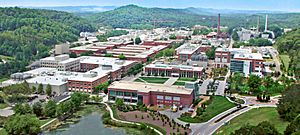
Tennessee has many large companies. Some big ones include FedEx and AutoZone in Memphis. Hospital Corporation of America is based in Nashville.
The area between Oak Ridge and Knoxville is known as the Tennessee Technology Corridor. It has over 500 high-tech companies. The Oak Ridge National Laboratory (ORNL) is a major research center. It does scientific research in many areas, including energy and national security.
Energy and Resources
The Tennessee Valley Authority (TVA) produces most of the state's electricity. Nuclear power is Tennessee's largest source of electricity. It produces about 43.4% of the state's power. Coal, natural gas, and hydroelectricity also contribute. Tennessee is a leader in hydroelectric power.
Tennessee has small amounts of coal, oil, and natural gas. It is the nation's leading producer of ball clay. Other important minerals include sand, gravel, and limestone. The Copper Basin was a major copper mining area for many years.
Tourism and Attractions
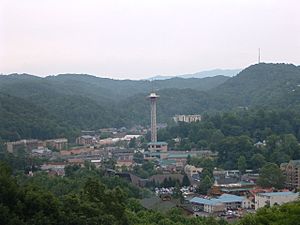
Tennessee is the 11th most visited state. It welcomed 126 million tourists in 2019. The top attraction is the Great Smoky Mountains National Park, with over 14 million visitors each year. This park is near Gatlinburg and Pigeon Forge. These towns have many attractions, including Dollywood.
Many places celebrate Tennessee's music history. These include Sun Studio in Memphis and the Country Music Hall of Fame and Museum in Nashville. Other popular spots are Graceland in Memphis and the Tennessee Aquarium in Chattanooga.
The National Park Service protects four Civil War battlefields in Tennessee. These include Shiloh National Military Park. Tennessee also has 56 state parks.
Culture: Music, Food, and More
Tennessee's culture is a mix of Southern Appalachian and Upland Southern styles. These come from its English, Scotch-Irish, and African roots. The state's three Grand Divisions also have their own cultural flavors.
Tennessee is famous for its music. It has played a big part in developing blues, country, rock and roll, and soul. Famous authors from Tennessee include Cormac McCarthy and James Agee. Tennessee is also known for its food, like Memphis-style barbecue and Nashville hot chicken.
Music: The Heartbeat of Tennessee
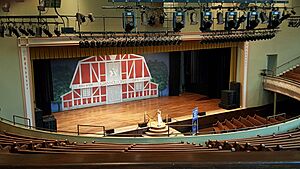
Many people consider Memphis's Beale Street the birthplace of the blues. Sun Records in Memphis was where rock and roll began in the 1950s. Artists like Elvis Presley and Johnny Cash started their careers there. Stax Records in Memphis was important for soul music.
The 1927 recording sessions in Bristol helped start country music. The Grand Ole Opry in Nashville helped make Nashville the center of country music. Nashville is now known as "Music City." The Grand Ole Opry is the longest-running radio show in the U.S.
Many museums celebrate Tennessee's music history. These include Sun Studio and the Stax Museum of American Soul Music in Memphis. In Nashville, you can visit the Country Music Hall of Fame and Museum and the Ryman Auditorium.
Education: Learning in Tennessee
The Tennessee Department of Education manages schools in the state. Public schools are run by county or city districts. Tennessee also has many private schools.
About 1 million students attend K–12 schools in Tennessee. In 2021, 88.7% of high school students graduated. Tennessee spends about $9,544 per student, which is one of the lowest amounts in the nation.
Colleges and Universities
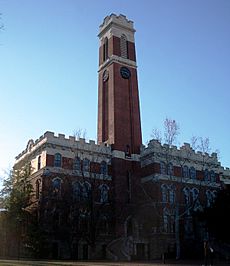
Public higher education is overseen by the Tennessee Higher Education Commission (THEC). The University of Tennessee system has campuses in Knoxville, Chattanooga, Martin, and Pulaski. The Tennessee Board of Regents (TBR) runs 13 community colleges and 27 technical colleges.
In 2014, the Tennessee Promise program was created. This program allows high school graduates in Tennessee to attend two-year colleges or trade schools tuition-free. This program aims to increase the number of college-educated residents.
Tennessee has 107 private colleges. Vanderbilt University in Nashville is a top research university. Nashville is sometimes called the "Athens of the South" because of its many colleges. Tennessee also has six historically Black colleges and universities (HBCUs).
Media: News and Entertainment
Tennessee has over 120 newspapers. Some of the largest include The Tennessean in Nashville and The Commercial Appeal in Memphis.
There are six main television markets in Tennessee: Nashville, Memphis, Knoxville, Chattanooga, Tri-Cities, and Jackson. Nashville's market is the third-largest in the Upland South. Tennessee has many TV and radio stations. The Grand Ole Opry radio show has been broadcasting since 1925.
Transportation: Getting Around Tennessee
The Tennessee Department of Transportation (TDOT) manages the state's roads. Tennessee has no transportation-related debts.
Roads and Highways
Tennessee has 96,167 miles (154,766 km) of roads. Of these, 14,109 miles (22,706 km) are maintained by the state. The state has 1,233 miles (1,984 km) of Interstate Highways. Tennessee has no toll roads.
Interstate 40 (I-40) is the longest Interstate in Tennessee, running for 455 miles (732 km). It connects Memphis, Nashville, and Knoxville. Other major Interstates include I-65, I-75, and I-24.
Airports and Flights
Major airports in Tennessee include Nashville International Airport (BNA) and Memphis International Airport (MEM). Memphis International Airport is the hub for FedEx Corporation. It is the world's second-busiest cargo airport. The state also has many smaller airports.
Railroads and Trains
For passenger trains, Memphis and Newbern are served by the Amtrak City of New Orleans line. Nashville has the WeGo Star commuter rail service. Tennessee has 2,604 miles (4,191 km) of freight train tracks.
Waterways and Ports
Tennessee has 976 miles (1,571 km) of navigable waterways. These include the Mississippi, Tennessee, and Cumberland rivers. The Port of Memphis is the fifth-largest inland port in the United States.
Law and Government: How Tennessee is Run
The Constitution of Tennessee was adopted in 1870. Nashville has been the capital since 1826. Before that, Knoxville and Murfreesboro were capitals.
State Government Branches
Tennessee's government has three branches, like the U.S. federal government. The executive branch is led by the governor. The governor serves a four-year term and can serve two terms in a row. The current governor is Bill Lee, a Republican.
The legislative branch is called the Tennessee General Assembly. It has two parts: the 33-member Senate and the 99-member House of Representatives. Senators serve four-year terms, and House members serve two-year terms.
Court System
Tennessee's highest court is the state Supreme Court. It has a chief justice and four other justices. The state's Attorney General is appointed by the Supreme Court. There are also lower courts, including the Court of Appeals and the Court of Criminal Appeals.
Tennessee has several law enforcement agencies. The Tennessee Highway Patrol (THP) enforces highway safety. The Tennessee Bureau of Investigation (TBI) handles criminal investigations.
Local Government
Tennessee has 95 counties. Most county governments have a county commission and an elected county executive. Nashville, Lynchburg, and Hartsville have governments that are combined with their county seats. Each county elects a sheriff and other officials.
Politics: How Tennessee Votes
The Republican Party is currently very strong in Tennessee. Republicans hold both U.S. Senate seats and most Congressional seats. They also control the state House and Senate. The Democratic Party is strongest in cities like Nashville and Memphis.
Tennessee does not require voters to declare a party when registering. Voters must show a photo ID.
After the Civil War, Tennessee was mostly Democratic. However, it had a large Republican minority. In the late 1800s, laws were passed that made it harder for African Americans to vote. This reduced their power in politics. After the Voting Rights Act of 1965, African Americans regained their full voting rights.
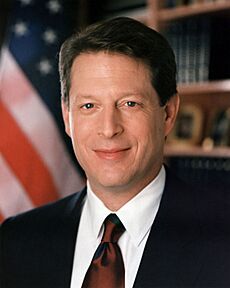
For much of the 1900s, Tennessee was a swing state in presidential elections. This means it could vote for either party. In the 2000 presidential election, Al Gore, who was from Tennessee, did not win his home state. This showed that Republican support was growing.

Since the early 2000s, Tennessee has become a strong Republican state. This is mainly due to white voters in rural areas. In the 2020 election, Tennessee voted Republican by the largest margin of any state.
Sports: Teams and Events
Tennessee has four major professional sports teams. The Tennessee Titans play in the National Football League (NFL). The Nashville Predators play in the National Hockey League (NHL). The Memphis Grizzlies play in the National Basketball Association (NBA). Nashville SC plays in Major League Soccer (MLS).
The state also has eight minor league teams. Four of these are Minor League Baseball teams. The Nashville Sounds and Memphis Redbirds play at the Triple-A level. The Knoxville Smokies and Chattanooga Lookouts play at the Double-A level.
Tennessee has three minor league soccer teams. It also has one minor league ice hockey team, the Knoxville Ice Bears.
The state is home to 12 college sports programs in NCAA Division I. Four of these play in the top level of college football. The Tennessee Volunteers play in the Southeastern Conference (SEC). The Vanderbilt Commodores are also in the SEC. The Memphis Tigers and Middle Tennessee Blue Raiders also have strong teams.
Tennessee is home to the Bristol Motor Speedway, which hosts NASCAR Cup Series races. The Nashville Superspeedway also hosts NASCAR races. The Iroquois Steeplechase horse race is held in Nashville each May.
Images for kids
See also
 In Spanish: Tennessee para niños
In Spanish: Tennessee para niños



